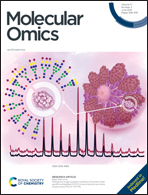Proteomic analysis of Listeria monocytogenes exposed to free and nanostructured antimicrobial lipopeptides†
Abstract
In this work, the effect of antimicrobial lipopeptide P34 on Listeria monocytogenes was evaluated for the first time through a proteomics approach. Bacteria were treated with sub-lethal doses of peptide P34 (F-P34) and P34 encapsulated into nanoliposomes (N-P34), while empty nanoliposomes (NE) and fresh buffer were used as controls. The proteomic analysis allowed the detection of one group of proteins commonly differentially represented in response to free and encapsulated P34 exposure. A second group of proteins was found to be exclusively differentially represented after exposure with encapsulated P34 only. The antimicrobial peptide P34 caused a significant downregulation of proteins associated with the transport of manganese and the over-representation of proteins related with iron transport in L. monocytogenes. In addition, reduction of stress tolerance proteins related to the σB and VirR regulons, together with the modulation of phosphoenolpyruvate phosphotransferase systems (PTS) for sugar transport were observed. The sugar and oligopeptide transporters regulated by antimicrobial action may influence the key virulence factor PrfA, reducing the pathogenicity of this microorganism.



 Please wait while we load your content...
Please wait while we load your content...